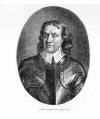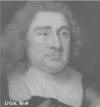|
Cromwell
in Scotland.
The
supremacy of Cromwell brought Scotland an unaccustomed
experience of general peace. For eight years the Scots had
been demanding ecclesiastical harmony of the
 English English
but in retaliation the Cromwellian regime enforced
political cooperation and ecclesiastical tolerance. With
and from this flowed a firm and impartial government that
was relatively honest, even handed and efficient. For good measure in
an act of considerable magnanimity ( though they did not see it as such), the Scots were offered
a union with England and representation in the English
Parliament .
In January
1652 a group of Commissioners assembled at Dalkeith with
the aim of implementing a union. The assembly formally
annulled every authority derived from Charles Stuart and
summoned the shires and burghs to send representatives to
meet with them. Here the representatives were given three
propositions:
1.
Acceptance of Parliament`s ` Tender` of union.
2.
Acknowledgment of Parliament`s authority in Scotland
3. To
provide information as to what was considered necessary to
bring the union into effect.
The shires
unanimously agreed with twenty nine of thirty one
accepting the Tender – Ayr and Renfrew dissenting. Of the
burghs fourteen out of fifty eight dissented being those
again in the south west of Scotland. The main and not
unexpected concern of the populace was the proposed
treatment of religion.
In England
there was a period of friction between Cromwell and
Parliament when Parliament was dissolved and the Bill of
Union was not passed. Again in the following Parliament
the Bill did not reach its third reading . On this
occasion Parliament yielded its power to Cromwell who then
issued his Instrument of Government on 16 December 1653
which established ` a Commonwealth of England, Scotland
and Ireland `. On 12 April 1654 the Protector and Council
passed the Ordinance of Union. which was Proclaimed in
Edinburgh on 4 May. The Bill of Union finally received
Parliamentary assent on 28 April 1657.
History
records a range of denunciations of Cromwell by the
Presbyterians, generally regarding him as a usurper,
although with time the vehemence of the language has
gradually diminished. But objectively, it has to be said
that Scotland as a whole derived much benefit. The Union
created representation of the people in the English /British Parliament; it ordained the
inclusion of the Cross of St Andrew in the Arms of the
Commonwealth in public seals; abolished the monarchy and
the right of the Estates to assemble; established free
customs between England and Scotland ; abolished vassals
and the feudal system; and forced a relative peace
throughout the land. On a lesser scale but of noticeable effect was the order of 24 December 1651 in Edinburgh that each house was to put out lighted candles (lamps) at night in winter between 6 and 9. The by product was easier and safer movement with less crime. The Diary of John Nicoll (1650-1667) tells that “the winter nicht wes almoist als licht as the day for multitude of lanthornes hung out by every hous.” He adds that the cost was about £45 Scots nightly, and fines of four shillings sterling (£2.8s.0d Scots) were imposed for failure to comply. At the same time Orders were issued that the filth and sewerage in the streets were to be cleaned up within 30 days and the practice of throwing water and night soil from windows was prohibited. In October 1655 a local tax or cess, was levied to pay for horse and carts to carry away the filth and muck. Ironically circumstances were not aided by a severe water shortage in the city during the autumn of 1654 and several huge fires, one in the Cowgate in October and another in Kirkheuch on 10 December in which much property and lives were lost. Nicoll records that “the pepill in Edinburgh were constrayned to go abroad the space of ane myle, before thai could get ony cleane watter, ather for brewing of aill or beir, or for thair pott meitt.”
Religion in many ways suffered through the intransigence of the Presbyterian ministers themselves. There was considerable bickering between them and even a split in the physical churches of Edinburgh. Since July 1650 the custom and practice of holding daily catechisms at 4 oclock in the afternoon fell into disuse, and a printed version was produced to be read by boys at the time of service. This apparent lack of enthusiasm had its negative effect on the people over time. On 1 August 1655 a celebration of the Communion was at last held in the city (having been witheld because of internecine bickering amongst the Presbyterians for six years). On 14 October of that year Patrick Gillespy, minister of Glasgow and author of the Remonstrance of 1650, was the first minister to publicly pray for Oliver Cromwell in Scotland.
In May 1655
a separate Council of State for Scotland was set up which
had two Scots among its nine members. In addition to
ensuring the continuance of the Union and the
establishment of good government, the Council were
directed to encourage the preaching of the Gospel;
encourage the growth of Universities and schools; purge
the burghs of disaffected magistrates; administer justice;
to approximate the judicial system to that of England;
encourage trade and foster the revenue. The burghs were
able to elect their magistrates and Justice of the Peace
courts were set up.
In the area
of religion the Cromwellian regime favoured the Protesters
against the Resolutioners essentially because they had a
history of being anti royalist. In a way this helped
balance the fact that about 750 of the total 900 ministers
in Scotland were Resolutioners. Cromwell had dissolved the
General Assembly in 1653 which was not to meet again for
the next thirty seven years. However, the Synods and
Presbyteries were allowed to continue their functions. In
1654 Scotland was divided into five provinces to which
were appointed `Provincial Certyfers` who were responsible
for appointments of ministers, control of the manses and
stipends. In 1655 the role of the Certifyers was passed to
the Presbyteries provided any new minister appointed
subscribed to live peaceably under the Protectorate.
A focal point for the dissenters/Resolutioners was Cromwell`s toleration of other religious sects. His position was explicitly stated by him to the Irish and was a dictum that applied to everybody :
“ As for the people, what thoughts in the matter of religion they have within their own breasts, I cannot reach; but shall think it my duty if they walk honestly and peaceably, not to cause them in the least to suffer for the same.”
In practice there was continued objection to `popery` , at least in England and Scotland. This was reinforced by the second Cromwellian Parliament in 1657 which resolved that the Scriptures should be the rule of faith. Moreover, believers in the Trinity and in the Scriptures should suffer no disability , unless they were Popish, prelatic, profligate , and blasphemous persons. In England the statute did not of itself supersede Presbytery and establish the Independents, but the Presbyteries , `Classes` as they were called , were unpopular and simply disappeared through constitutional weakness. In Scotland they were allowed to continue always provided they were peaceable.
On 3
September 1658 (his lucky day after the battles of Dunbar and Worcester)
the Lord Protector, Oliver Cromwell died, leaving the
reins in the hands of his son Richard who was not of his father`s calibre. In a short space of time Richard
Cromwell departed from the scene and the army was left in
power The demand for parliamentary power and abolition of
rule by the sword gathered momentum in England but it was
in Scotland
 that that
action took place. Here Lt. General Monk had discussions with Archbishop Sharp and summoned
representatives to Edinburgh to launch his plan to
restore a Scottish king and Scotland`s independence. They
were charged with maintaining order in his absence while
he and his army marched to London, arriving in February
1660. The English Parliament was restored and the issue of
the Union was raised but discussion was not serious. In
their fourth session in April the Parliament voted in
favour of restoring the old constitution and Scotland had
her independence and monarch once more. Charles was
consulted by emissaries and the second
Declaration at Breda
(almost certainly based on suggestions made by Monk)
confirmed his return. The terms this time were not
dictated by Presbyterian zealots, and were much more acceptable
to Charles. With it came a vengeful Restoration and in
Scotland twenty eight years of oppression, including the
“Killing Time” of 1685, and the attempt of James II to
restore the supremacy of the Catholic Church.
Next. The
Restoration of Charles II.
18/07/2011
|